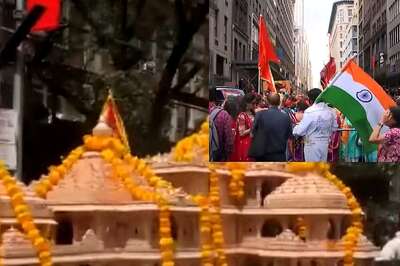
views
Recently, the Election Commission of India (ECI) attempted to reinforce and shape the model code of conduct for political parties on the promises made in election manifestos. The ECI has decided that disclosure forms will be necessary for political parties. The form will provide details of modes of revenue generation, explaining spending, impact on state’s balance sheet and increase in state debt, among other things.
Are these forms curbing the freedom of expression of political parties?
I guess not.
Several Indian voters at large idolize their leaders and believe everything they say and the media shows about them.
THE SURVEY
In a survey conducted by Indian Institute of Management (IIM), Rohtak across 20 states, it was found that a majority of individuals in the 18-25 age group, who did not have even high school education (64%), tended to believe political speeches and briefs conveyed through media outlets.
Also, 52% of the respondents stated that getting free products and services is the primary motivation for them to vote. In other words, everything vocalized by a political leader during a political rally is an explicit assurance to the electorate of that promise being fulfilled if the leader comes into power.
Political parties would justify their rallies based on the right to freedom of speech and expression, but the question that arises is — Should there be any limits to such freedom in the larger interest of the nation?
This is because the history of elections in India has been testimony to the fact that several promises that have been made to the public have either never been fulfilled, or if fulfilled, have had drastic negative impact on the overall finances of the government.
The latest directions by the ECI have attempted to put limits on the political party’s ability to give promises to allure voters.
THE DIFFERENCE
In simple words, freebies are like grants. They are not backed by budgets and pre-allocated resources, and are aimed at benefiting the targeted population in the short term. Welfare schemes, on the other hand, are well thought-after plans. They aim to benefit the target population and improve their standard of living and access to resources.
Parallels to this can be drawn from the Motivation and Hygiene theory by Frederick Herzberg, laid out in the context of employee motivation and work conditions. It states that hygiene factors are those whose mere absence causes dissatisfaction. And there are motivation factors, over and above the hygiene factors, which help increase satisfaction.
Applying the theory, welfare schemes such as equitable access to healthcare, primary education and food security categorise as hygiene factors. Any social amenity that improves standard of living, but does not qualify as a pre-requisite to living, like electricity, loan waivers, increased pension and internet access characterise as motivation factors.
Thinking of welfare schemes as hygiene factors and freebies as motivation factors, it is indisputably the prime responsibility of political parties to understand the differences between freebies and welfare schemes. This would restrain them from promising anything that cannot be fulfilled, given the boundaries of financial or human resources. The promise or distribution of irrational freebies just before the election process influences the voters to exercise their franchise in a certain manner. It makes them biased towards a political party and go against the idea of ‘free and fair’ elections.
DISINCENTIVE?
In the past, several political parties have listed political agendas like waiving farmer loans, massive cash transfers to poor families, increased unemployment allowances, subsidised electricity and water, free travel for a certain section of the population in government buses, and metro, among several others. But what they might have failed to consider is that the idea of freebies acts as a disincentive for people to not contribute effectively to economic development and GDP.
For instance, a research conducted by IIM Rohtak in 2020 indicates that waiving loans would induce farmers to take more loans in the future and not repay them. This would severely impact the financial stability of the country.
The current outstanding farmer loans stand at ₹18.4 lakh crore as for the year 2020-21, and waiving them would pave a path towards bankruptcy. Similarly, increases in unemployment allowance would cause the youth to diverge from contributing to the country’s development, and rather engage in activities such as gambling and lottery. It is also likely that they get involved in substance abuse, domestic violence and other forms of inappropriate social behaviour. The impact of this path, when taken by the youth, would be disastrous for the country and would deter its development.
THE SOLUTION
In view of the problems, the Election Commission of India’s proposal to introduce a standardised disclosure proforma, in consultation with major stakeholders, proves to be a feasible solution. Under its mandate, the ECI directs political parties to lay out a proforma entailing a detailed qualitative and quantitative disclosure of the promises made, their details, targeted population, beneficiaries covered, financial implications and ways and means of raising resources to meet the said expenditure.
Part B of the proforma is to be filled by the State or Central government. It would list out complete details about the current revenue receipts in the form of tax or non-tax revenue and grants, government expenditure, other liabilities and borrowings, and the Gross Domestic Product of the nation and the states in nominal terms. This would assist contesting political parties in assessing the reasonability of the resource procurement strategy and devising a logical estimate of appropriating the required funds in the execution of every promise made in the election manifesto.
Through these measures, the ECI is not attempting to curb the freedom of expression of political parties, but is actually making them accountable for what they speak. In other words, false and fake promises are then inviting voters to vote under false pretences.
The ECI is attempting to engage the parties in model code of conduct. These measures would further increase transparency and the credibility of those promises and their rationale by indicating the means to fulfil them.
With research assistance by L Shruti. Prof Dheeraj Sharma is the Director, IIM Rohtak. The views expressed by the author are personal and do not represent the stand of the publication.
Read all the Latest Opinion News and Breaking News here

















Comments
0 comment